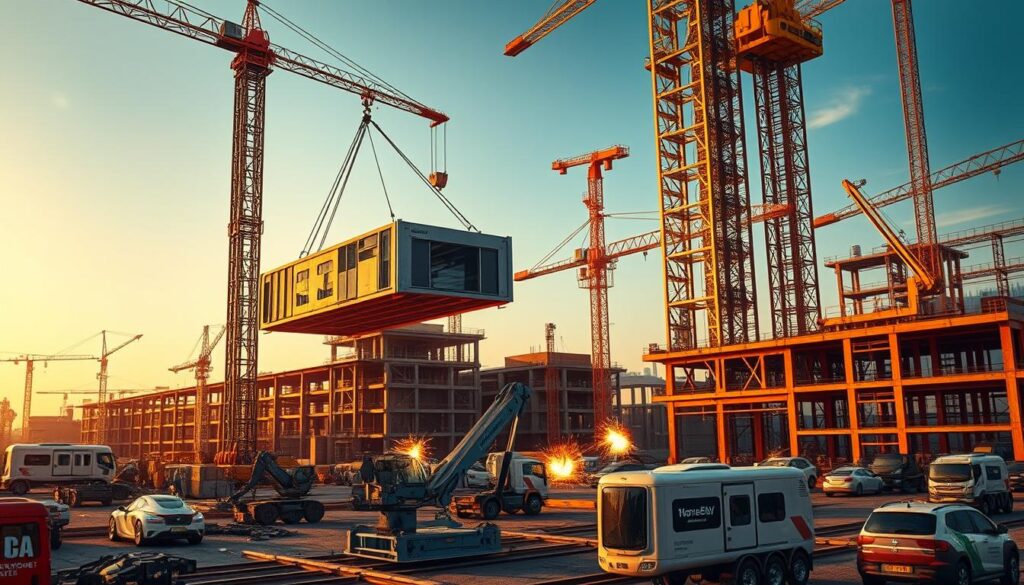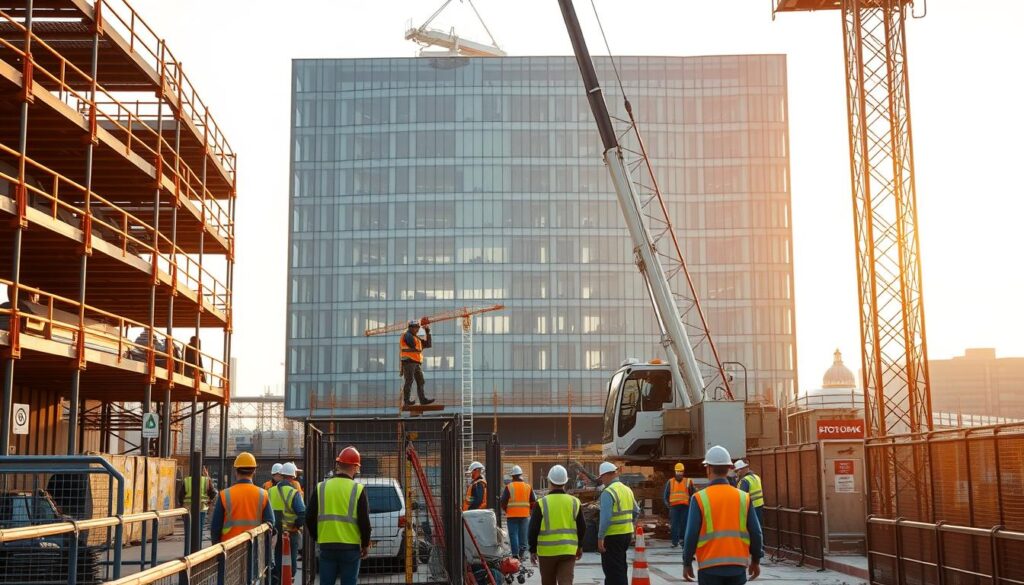The construction industry in the United States is witnessing a significant transformation, driven by the adoption of innovative engineering solutions. With infrastructure projects on the rise, the demand for efficient and sustainable building practices has never been more pressing.
Through innovation, collaboration, and technology, we deliver smarter, safer, and more impactful engineering solutions that enhance communities and shape the future of our infrastructure. This approach not only improves the quality of construction projects but also ensures they are environmentally friendly and meet the evolving needs of the population.
Key Takeaways
- Innovative engineering solutions are transforming the construction industry.
- Collaboration and technology are key drivers of this transformation.
- Efficient and sustainable building practices are becoming the norm.
- Smarter engineering solutions enhance community development.
- The future of infrastructure is being shaped by these advancements.
Understanding Integrated Engineering Solutions
The concept of integrated engineering solutions is revolutionizing the construction industry by fostering collaboration among various engineering disciplines. This approach ensures that different aspects of a project are considered holistically, leading to more efficient and effective solutions.
What Are Integrated Engineering Solutions?
Integrated engineering solutions involve the coordination of multiple engineering disciplines to develop comprehensive solutions for construction projects. This includes structural engineering, mechanical systems, and electrical engineering, among others. By working together, these disciplines can address complex project requirements more effectively.
Our integrated engineering process at CDI Engineering Solutions involves multiple engineering disciplines working in conjunction with other project disciplines to develop solutions for your project. This collaborative approach ensures that all aspects of the project are considered, resulting in more cohesive and effective project outcomes.
Importance in Construction and Building Technology
Integrated engineering solutions are crucial in construction and building technology as they enable the delivery of complex projects with enhanced efficiency and reduced costs. By leveraging construction technology advancements, these solutions can improve project outcomes and meet the evolving demands of the industry.
| Benefits | Description | Impact |
|---|---|---|
| Enhanced Collaboration | Multiple disciplines work together | More cohesive project solutions |
| Increased Efficiency | Streamlined processes and reduced errors | Cost savings and faster project delivery |
| Improved Innovation | Integration of various engineering disciplines | More innovative and effective solutions |
For students and professionals looking to enhance their knowledge in civil engineering, exploring resources such as top US colleges for civil engineering can provide valuable insights into the field.
The Role of Technology in Construction

The construction industry is undergoing a significant transformation with the integration of advanced technologies. From digital twins and AI-driven analytics to 3D printing and immersive reality solutions, the sector is witnessing a paradigm shift in how projects are designed, inspected, and managed.
Innovations Transforming the Industry
The construction industry is benefiting from various technological innovations. Digital twins, for instance, allow for the creation of virtual replicas of physical projects, enabling real-time monitoring and predictive maintenance. AI and automation are streamlining processes, reducing manual labor, and improving accuracy.
Some of the key technologies transforming the industry include:
- Building Information Modeling (BIM)
- 3D printing for complex structures
- Immersive reality for enhanced visualization
- IoT devices for real-time monitoring
The Impact of AI and Automation
AI and automation are having a profound impact on construction. They are not only improving efficiency but also enhancing safety and reducing costs. For example, AI-driven analytics can predict potential project delays, allowing for proactive measures to be taken.
| Technology | Application | Benefit |
|---|---|---|
| AI-driven Analytics | Predictive Maintenance | Reduced Downtime |
| Automation | Construction Processes | Increased Efficiency |
| Digital Twins | Project Monitoring | Improved Accuracy |
As the construction industry continues to embrace these technologies, we can expect to see significant improvements in project outcomes. The integration of USA engineering solutions with cutting-edge technologies is set to revolutionize the sector, driving growth and innovation.
Key Components of Integrated Engineering Solutions
Integrated engineering solutions represent a holistic approach to construction, incorporating various engineering disciplines to achieve superior results. Our services include structural engineering, mechanical engineering, electrical engineering, and sustainable practices to deliver comprehensive solutions for construction projects.
Structural Engineering Insights
Structural engineering is a critical component of integrated engineering solutions, focusing on the design and analysis of building structures to ensure stability, durability, and safety. By leveraging advanced software and techniques, structural engineers can optimize building designs, minimize material usage, and reduce costs. For instance, our team has successfully implemented structural engineering solutions in various projects, resulting in improved building performance and reduced environmental impact.
Mechanical and Electrical Systems
Mechanical and electrical systems are vital to the functioning of modern buildings. Integrated engineering solutions encompass the design and integration of these systems to enhance building efficiency, comfort, and sustainability. By optimizing mechanical and electrical systems, our team can help reduce energy consumption, lower operating costs, and improve occupant satisfaction. A detailed analysis of these systems can be found in our engineering labs document.
Sustainable Practices in Engineering
Sustainable practices are increasingly important in modern engineering, as they help minimize environmental impact, reduce waste, and promote eco-friendly construction methods. Our integrated engineering solutions incorporate sustainable practices, such as energy-efficient design, renewable energy systems, and green building materials, to create environmentally responsible buildings. By adopting these practices, construction projects can not only reduce their environmental footprint but also benefit from cost savings and enhanced market value.
In conclusion, the key components of integrated engineering solutions work together to provide comprehensive and effective solutions for construction projects. By combining structural engineering insights, mechanical and electrical systems, and sustainable practices, our team can deliver projects that are efficient, sustainable, and tailored to our clients’ needs.
Benefits of Integrated Engineering in Construction

The adoption of integrated engineering solutions is leading to improved project efficiency, cost-effectiveness, and enhanced collaboration in the construction industry. By streamlining processes and fostering better communication among stakeholders, integrated engineering is transforming the way construction projects are executed.
Enhanced Project Efficiency
Integrated engineering solutions enhance project efficiency by allowing for a more cohesive and coordinated approach to construction. This leads to reduced errors and rework, as well as improved productivity.
Key benefits include:
- Streamlined project workflows
- Improved collaboration among teams
- Reduced project timelines
As noted by industry experts, “Integrated engineering is not just about combining different engineering disciplines; it’s about creating a seamless and efficient process that benefits the entire project lifecycle.”
“The future of construction is in integrating different systems and processes to achieve more with less.”
Cost-Effectiveness and Resource Management
Integrated engineering solutions also contribute to cost-effectiveness and better resource management. By optimizing resources and minimizing waste, construction projects can achieve significant cost savings.
| Aspect | Traditional Approach | Integrated Engineering Approach |
|---|---|---|
| Cost Management | Often fragmented, leading to cost overruns | Holistic approach, optimizing costs across the project |
| Resource Allocation | Can be inefficient, with underutilization or overutilization | Optimized resource allocation, reducing waste |
Improved Communication and Collaboration
Effective communication and collaboration are critical to the success of construction projects. Integrated engineering fosters a collaborative environment, ensuring that all stakeholders are aligned and working towards the same goals.
Increased collaboration and transparency help teams overcome common challenges more efficiently, preventing costly errors and reducing the total cost of ownership. By leveraging integrated engineering solutions, construction projects can achieve better outcomes and improved client satisfaction.
The Process of Implementing Integrated Solutions
The successful delivery of integrated engineering projects hinges on a meticulous planning process. This involves several critical phases that ensure the project is executed efficiently and effectively.
Phases of Construction Planning
Construction planning is a multifaceted process that includes several key phases:
- Project Initiation: Defining project scope, goals, and deliverables.
- Design and Planning: Creating detailed designs and plans, including architectural, structural, mechanical, and electrical components.
- Pre-construction: Conducting site analysis, obtaining necessary permits, and preparing the site for construction.
- Construction Execution: Carrying out the actual construction work according to the plans and specifications.
- Project Monitoring and Control: Tracking project progress, identifying and mitigating risks, and ensuring compliance with quality standards.
As noted by industry experts, “Effective construction planning is the backbone of any successful project.” Implementing new technologies in construction planning can significantly enhance project outcomes.
Risk Assessment Strategies
Risk assessment is a critical component of integrated construction solutions. It involves identifying potential risks, analyzing their impact, and developing strategies to mitigate them.
| Risk Category | Risk Factors | Mitigation Strategies |
|---|---|---|
| Financial Risks | Cost overruns, funding issues | Detailed budgeting, contingency planning |
| Operational Risks | Delays, equipment failure | Regular maintenance, backup plans |
| Safety Risks | Accidents, health hazards | Safety training, compliance with regulations |
Collaboration Among Stakeholders
Collaboration among stakeholders is essential for the successful implementation of integrated construction solutions. This includes:
“Collaboration is key to delivering successful construction projects. By working together, stakeholders can ensure that projects are completed on time, within budget, and to the required quality standards.”
Effective collaboration involves regular communication, shared goals, and mutual respect among all parties involved.
Case Studies: Successful Projects in the USA

Integrated engineering solutions have led to groundbreaking projects across the USA, transforming the construction landscape. These projects not only showcase the potential of integrated engineering but also highlight the benefits of adopting such comprehensive approaches.
Large Scale Developments
Large-scale developments in the USA have successfully integrated engineering solutions, resulting in projects that are both efficient and innovative. For instance, the development of new commercial hubs has incorporated advanced structural engineering insights, ensuring stability and durability.
Key features of these developments include:
- Advanced mechanical and electrical systems that optimize energy use
- Innovative structural designs that enhance building longevity
- Sustainable practices that minimize environmental impact
These features collectively contribute to the success of large-scale developments, making them exemplary models for future projects.
Sustainable Building Initiatives
Sustainable building initiatives have gained significant traction in the USA, with many projects achieving remarkable energy efficiency and reduced carbon footprints. These initiatives often involve the use of green building materials, renewable energy sources, and advanced technologies to minimize environmental impact.
The success of these initiatives can be attributed to:
- Effective collaboration among stakeholders, including architects, engineers, and contractors
- The integration of sustainable practices into every phase of the project
- Continuous monitoring and optimization of building performance
By adopting sustainable building initiatives, developers can create buildings that are not only environmentally friendly but also cost-effective in the long run.
Our highlighted projects demonstrate how integrated engineering solutions have helped facility operators reduce project TIC and asset TCO, and implement complex new technology for emerging energy start-ups. These case studies serve as valuable references for understanding the practical applications and benefits of integrated engineering solutions in the USA.
Integrated Engineering and Sustainability
As the construction industry evolves, the integration of sustainable practices has become a cornerstone of modern engineering. Through ethical practices, environmental stewardship, and community engagement, we design and build infrastructure that enhances lives and fosters long-term resilience.
The relationship between integrated engineering and sustainability is multifaceted, involving the adoption of green building certifications and the implementation of energy-efficient designs. This synergy not only benefits the environment but also enhances project efficiency and reduces costs.
Green Building Certifications
Green building certifications, such as LEED (Leadership in Energy and Environmental Design), play a crucial role in promoting sustainable construction practices. These certifications recognize buildings that meet rigorous standards for energy efficiency, water usage, and environmental sustainability.
- LEED Certification: Encourages the use of sustainable materials, reduces energy consumption, and promotes eco-friendly design.
- Benefits of Green Building Certifications: Include improved indoor air quality, reduced operational costs, and enhanced marketability of the property.
As stated by the U.S. Green Building Council, “Green buildings can reduce energy consumption by up to 30% and water usage by up to 50% compared to traditional buildings.”
“Sustainability is not just about being green; it’s about being smart and responsible with our resources.”
Energy Efficiency in Construction
Energy efficiency is a critical aspect of sustainable construction. By incorporating advanced technologies and materials, builders can significantly reduce the energy footprint of their projects.
Some strategies for enhancing energy efficiency include:
- Using high-performance insulation to minimize heat loss.
- Installing energy-efficient HVAC systems.
- Incorporating renewable energy sources, such as solar panels.
By adopting these strategies, construction projects can not only reduce their environmental impact but also achieve significant cost savings over time.
Challenges Faced in Integrated Engineering

As construction technology advancements continue to evolve, the industry must also navigate the complexities associated with integrated engineering. The integration of various engineering disciplines into a cohesive project delivery system is fraught with challenges that can impact project timelines, budgets, and overall quality.
Overcoming Technological Barriers
One of the significant challenges in integrated engineering is overcoming technological barriers. The adoption of new technologies and software requires substantial investment in training and infrastructure. Moreover, ensuring compatibility and interoperability between different systems can be a complex task. For instance, the integration of advanced construction technologies with existing engineering solutions demands careful planning and execution.
The industry is moving towards more collaborative and integrated approaches, leveraging technologies like Building Information Modeling (BIM) and Artificial Intelligence (AI). However, the transition to these technologies can be daunting for some firms, particularly smaller ones with limited resources.
Managing Diverse Stakeholder Interests
Another critical challenge is managing diverse stakeholder interests. Integrated engineering projects involve multiple stakeholders, including clients, architects, engineers, contractors, and regulatory bodies. Each of these stakeholders may have different priorities, expectations, and communication preferences, making it essential to have effective stakeholder management strategies in place.
Flexibility and understanding different client requirements are key to developing a successful partnership. Sometimes, engineering services companies may try to force clients to accept a certain way of project execution, which can be a challenge. By adopting a client-centric approach and being adaptable to their needs, companies can build trust and ensure project success.
For more insights on tackling the challenges in integrated engineering, exploring resources such as global perspectives on engineering challenges can provide valuable information and strategies.
Future Trends in Integrated Engineering Solutions
Emerging trends in integrated engineering solutions are set to transform the construction sector. As we embrace emerging technologies to enhance efficiency, accuracy, and problem-solving across engineering and construction projects, we’re delivering forward-thinking solutions that drive progress.
Modular Construction on the Rise
Modular construction is gaining traction as a significant trend in integrated engineering. This method involves constructing modules in a factory and then assembling them on-site, reducing construction time and improving quality control. According to recent industry insights, modular construction can reduce project timelines by up to 50% and lower costs by minimizing on-site labor.
The benefits of modular construction are multifaceted. It not only accelerates project delivery but also enhances sustainability by reducing waste and improving energy efficiency. As noted in a report by Deloitte, the adoption of modular construction is expected to grow, driven by its potential to improve project outcomes.
Innovations in Smart Buildings
Another significant trend is the development of smart buildings, which integrate advanced technologies to enhance building performance, occupant comfort, and energy efficiency. Smart buildings utilize sensors, IoT devices, and data analytics to optimize building operations, creating a more responsive and efficient built environment.
The integration of smart technologies in buildings is not just about energy efficiency; it’s also about creating healthier and more productive spaces for occupants. For instance, smart buildings can adjust lighting and temperature based on occupancy, improving comfort and reducing energy consumption. As discussed on World Civil Society, innovations in construction technology are pivotal in shaping the future of infrastructure projects, including smart buildings.
| Trend | Description | Benefits |
|---|---|---|
| Modular Construction | Constructing modules in a factory and assembling them on-site. | Reduced project timelines, lower costs, improved sustainability. |
| Smart Buildings | Integrating advanced technologies to enhance building performance and occupant comfort. | Improved energy efficiency, enhanced occupant experience, optimized building operations. |
As the construction industry continues to evolve, embracing these trends will be crucial for companies looking to stay ahead. By leveraging construction technology advancements, such as modular construction and smart buildings, the industry can achieve greater efficiency, sustainability, and innovation.
Choosing the Right Engineering Partner

The right engineering partner can make all the difference in delivering your project on time and within budget. A reliable partner ensures that your project benefits from their expertise, experience, and innovative solutions.
Key Qualities to Look For
When searching for an engineering partner, there are several key qualities to consider. These include:
- Experience: Look for a partner with a proven track record in handling projects similar to yours.
- Expertise: Ensure they have the necessary technical expertise and knowledge in integrated engineering solutions.
- Innovative Approach: A good partner should be able to bring innovative solutions to the table, enhancing your project’s efficiency and sustainability.
- Communication Skills: Effective communication is crucial. Your partner should be able to clearly articulate their plans, progress, and any challenges.
For more insights on selecting the right partner, especially for MEP services, you can refer to this guide on choosing the right MEP services provider in the.
Questions to Ask Potential Partners
To further assess potential engineering partners, prepare a list of questions to ask during your initial consultations. Some essential questions include:
| Category | Questions |
|---|---|
| Experience and Expertise | Can you share examples of similar projects you’ve completed? What specific expertise do you bring to integrated engineering solutions? |
| Innovation and Approach | How do you stay updated with the latest technologies and trends? Can you describe your approach to sustainability in engineering? |
| Project Management | How do you manage project timelines and budgets? What strategies do you use to mitigate risks? |
By carefully evaluating potential partners based on these qualities and questions, you can make an informed decision that will positively impact your project’s outcome.
Regulations and Standards in the USA
Compliance with USA engineering solutions regulations is not just about avoiding legal issues; it’s about ensuring the longevity and safety of construction projects. The regulatory landscape in the USA is complex, involving various federal, state, and local regulations.
The construction industry is heavily influenced by these regulations, which are designed to ensure safety, efficiency, and sustainability. Understanding and adhering to these standards is crucial for the success of any construction project.
Understanding Building Codes
Building codes are sets of rules that govern the design, construction, and occupancy of buildings. In the USA, these codes are developed and enforced by various authorities, including the International Code Council (ICC). The USA construction and engineering law is significantly influenced by these codes.
The most widely adopted building code in the USA is the International Building Code (IBC), which provides comprehensive regulations for building design, materials, and construction practices. Compliance with these codes is essential for ensuring that buildings are safe, accessible, and energy-efficient.
Importance of Compliance in Engineering Solutions
Compliance with building codes and regulations is critical in engineering solutions. It ensures that projects are executed with the highest standards of safety and quality. Non-compliance can lead to severe consequences, including legal penalties, project delays, and increased costs.
Moreover, compliance is not just about avoiding negative outcomes; it’s also about achieving positive results. By adhering to regulations, engineers and constructors can enhance the value of their projects, improve public perception, and contribute to sustainable development.
| Aspect | Description | Benefit |
|---|---|---|
| Safety | Adherence to safety standards and codes | Reduced risk of accidents and injuries |
| Sustainability | Compliance with environmental regulations | Enhanced sustainability and reduced environmental impact |
| Quality | Adherence to quality standards and best practices | Improved project outcomes and client satisfaction |
In conclusion, understanding and complying with regulations and standards in the USA is fundamental to the success of construction and engineering projects. By prioritizing compliance, stakeholders can ensure that their projects are safe, sustainable, and of high quality.
How Integrated Engineering Enhances Safety

Safety is a paramount concern in construction, and integrated engineering solutions are pivotal in ensuring it. By combining advanced technology and collaborative project delivery methods, integrated engineering enhances safety protocols and promotes a culture of safety among workers.
Safety Protocols in Construction
Effective safety protocols are the backbone of any successful construction project. Integrated engineering solutions facilitate the implementation of robust safety measures by leveraging technologies such as Building Information Modeling (BIM) and advanced data analytics. These technologies enable the identification of potential hazards early in the project lifecycle, allowing for proactive mitigation strategies.
Moreover, integrated engineering promotes a holistic approach to safety by considering the interplay between different project components. This comprehensive understanding helps in designing safety protocols that are tailored to the specific needs of each project, thereby enhancing overall safety.
Training and Development for Workers
Training and development are critical components of a safety-conscious construction environment. Integrated engineering solutions support the creation of customized training programs that address the specific safety challenges faced by workers on a particular project. By utilizing virtual reality (VR) and augmented reality (AR), workers can be trained in a simulated environment, preparing them for potential hazards they may encounter on site.
Furthermore, integrated engineering fosters a culture of continuous learning and improvement. By analyzing data from past projects, construction companies can identify areas for improvement and develop targeted training initiatives to address these gaps, ultimately leading to a safer working environment.
Conclusion: The Future of Integrated Engineering in Construction
The construction industry is on the cusp of a revolution, driven by integrated engineering solutions that are transforming the way projects are planned, executed, and maintained.
Evolving Landscape
As the industry continues to evolve, it’s essential to adapt to new technologies and methodologies that enhance project efficiency, sustainability, and safety. The future of construction relies heavily on innovation, with a focus on delivering forward-thinking solutions that drive progress and add value for clients.
Innovation in Engineering
By embracing innovation in integrated engineering solutions, the construction industry can create a more sustainable, efficient, and safe built environment. This involves leveraging cutting-edge technologies, such as Building Information Modeling (BIM) and digital twins, to improve project outcomes and reduce environmental impact.
